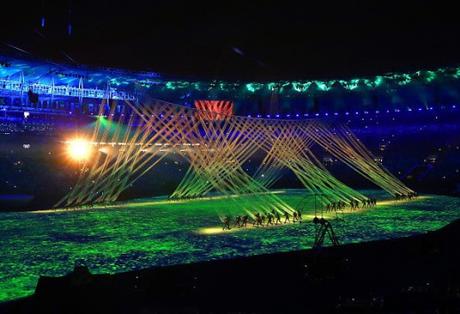 Rio 2016 Opening Ceremony: Grass Huts by Native Performers, August 5, 2016
Rio 2016 Opening Ceremony: Grass Huts by Native Performers, August 5, 2016Honor Thy National Anthem
Discerning viewers should bear in mind that London’s 2012 Summer Olympics Games closed with the same “Aquele abraço” theme song. While retaining the original’s lyrics, the vastly pared-down number, as it was presented at Rio 2016, lacked the stridency and gruffness of songwriter Gilberto Gil’s 1969 extended play recording (which this author once owned and can safely vouch for).
Produced by Manoel Barenbein for the Philips label and arranged by Rogério Duprat and Chiquinho de Moraes, the number’s rasping power and jarring orchestration contrasted with Luiz Melodia’s more contemplative, down-to-Google-earth interpretation — Gil Unplugged!
At that same London 2012 closing ceremony, one of Brazil’s top-rated performers was carried aloft by giant pale-blue flower petals. With arms outstretched and dressed in a flowing white gown, the raven-haired vocalist regaled London’s Olympic Stadium audience with her haunting delivery of the opening melody to Heitor Villa-Lobos’ Bachianas Brasileiras No. 5.
The tune was one of many such efforts by the inexhaustible carioca composer to blur the lines between classical and popular compositions. But who was this ravishing starlet, this improvised Brazilian Fat Lady? It was none other than Marisa Monte, and the melody played perfectly into her hands (or, should I say, her voice). Little did viewers suspect that the teenaged Marisa had once spent a year studying opera in Italy before returning home to Rio.
Adding to the list of headliners, top model Alessandra Ambrósio participated in the closing ceremony, as did singer-turned-actor Seu Jorge and rapper B-Negão. Former soccer great and ex-minister of sport Pelé paid a surprise visit, too, as “Aquele abraço” reached its peak. Amid a stream of dancers in typical Oba-Oba form, the plan was to build anticipation for an Olympic-style Carnival to come, an all-out celebration to include drum-corps pounding, sultry samba dancing, multihued outfits, and that ebulliently festive atmosphere.
Returning to Rio 2016, I made note of some shockingly slipshod attempts by English-speaking announcers to pronounce the many indigenous names that abound in Brazilian Portuguese. I realize, as most native speakers do, that the language is not the easiest one to enunciate. However, and at the instigation of more enlightened minds, when reporting on events from the actual physical sites newscasters should have at least tried to master the correct manner of articulation before airtime.
For instance, the name Maracanã (pronounced Mah-rah-cah-NÃ), a word with a nasally-produced final syllable that resonates in the back of the throat, became Mara-CAHN-a in the mouths of reporters. And instead of futebol, the Brazilian-Portuguese literation of “soccer,” the word futbol (in the Spanish-language spelling) scrolled across viewers’ screens. In the same league as the spelling and pronunciation issues, the redundant phrase “Carnival capital of the world,” used to describe Brazil’s party-hearty host city, quickly became an overworked cliché.
Just the same, the Maracanã stadium’s field resembled a visual map of Brazil. Onto this digitally-enhanced encampment, carioca native Paulinho da Viola (né Paulo César Batista de Faria) materialized, strumming a solo guitar and seconded by an eight-piece string section. This is where the creative directors’ plans for the Rio 2016 opening ceremony came into their own.
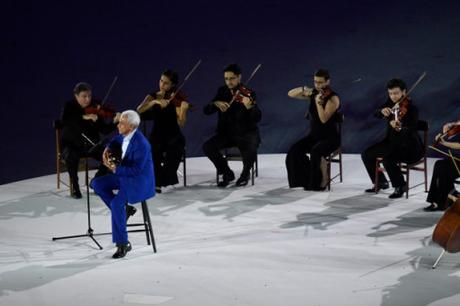
After all the pomp of military bands and symphony orchestras; after so many pretentious arrangements for grand piano and choirs of fifty thousand or more voices; and after the circumstance surrounding the pointless chest-beating at the 2014 World Cup, listeners were spellbound by the hushed elegance of Paulinho’s intimate take on the country’s Hino Nacional.
This was no time for posturing or empty-headed braggadocio on the former soccer field of shattered dreams. Instead, Brazil laid bare her musical soul. With reverence and retrospection, the coordinators of the opening program opted to look inward, to go back to the country’s pop-music beginnings: to samba and bossa nova.
It was as if João Gilberto himself, who slowed down samba’s rhythmic impulses to barely whispered cadences, were physically present that August evening. We know that wasn’t the case. Still, Joãozinho’s essence was carried forward in Paulinho da Viola’s gorgeously understated, two-minute-and-twenty-two-second presentation that set the tone for the sixteen-day event.
Forcing viewers to lean forward in their seats, it commanded their attention by urging them to follow along with the words. This was a multi-part conversation that brought people nearer to today’s Brazilian reality, an invitation to take part in a national ritual. The producers exceeded expectations by toning down the bombast to a mild trickle. The mood was surprisingly stirring and respectful.
As Paulinho continued to enthrall listeners, a group of young people, wrapped in the country’s colors, mounted a circular platform where the flag-raising ceremony would be observed. The platform was inspired by the spherical discs flanking the modernistic structures of the capital Brasília’s National Congress. As deferential as boy scouts, the group gathered at the flagpole’s base to pay respect to the Brazilian flag. A jet of air, pumped through the flagpole’s core from its base below ground, gave the impression of a banner waving in the night.
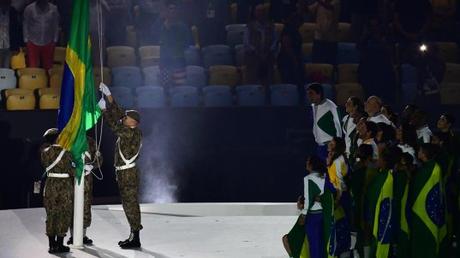
Brazil sang, and the world sang with her. A sense of pride swelled up in the audience and in our home; a pride that, frankly, hasn’t always been felt considering what the country has been going through these past few years.
In all probability, the idea for this smaller-scaled treatment may have begun with London 2012’s closing ceremony. During the handing over of the Olympic Flag portion of the program, the tradition of playing the new host-country’s national anthem was followed. It was carried out by a recording of a military band intoning Brazil’s Hino Nacional over the Olympic Stadium’s loudspeaker system, in a controversial “shortened” edition that eliminated an entire verse.
Now imagine if you will a scenario of patriotic American baseball or football fans, hearing “The Star-Spangled Banner” at a stadium in the U.S. After the section, “Whose broad stripes and bright stars, through the perilous fight / o’er the ramparts we watched were so gallantly streaming?” they realize that the bridge, “And the rocket’s red glare, the bombs bursting in air, gave proof through the night that our flag was still there,” had been edited out. This glaring omission would be taken as an insult to the host nation, and would no doubt have sparked an international incident. Summon the secretary of state! On the double, pronto!
Mercifully, when Brazilians in Brazil hear their Hino Nacional, it is given complete. At least, the first stanza is complete. As we know, there are several other stanzas to confront, as there are with America’s “Star Spangled Banner” and numerous other hymns of the nation. These are normally omitted in order to save time.
Besides all that, how many people memorize all of the stanzas to their country’s national anthem? Not many, I’d be willing to bet.
Birth of the Brazilian Nation
The next section introduced the story of the founding of the land we call Brazil (named after the Brazilwood, or Paubrasilia that once thrived there), of the indigenous native population that abounded, of the birds and beasts that inhabited the densely forested continent: Terra Brasilis.
In an intricately choreographed segment, performers in native costume (actual descendants, in fact) danced around the arena creating images of grass huts with gigantic ribbon strands. Then, the first Europeans, the Portuguese, arrived in their caravels. The bouncing prows of the highly maneuverable ships carrying the bearded and longhaired Portuguese inspired awe and curiosity among the natives. The Portuguese carved a trail through the Brazilian landscape, leaving their mark behind.
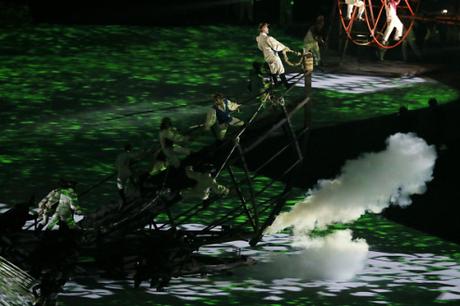
This was followed by the African slaves, towing their plows, laden down by their shackles and chains, tearing up the land with massive paddlewheels, working the sugar plantations. The analogy to the Hebrew slaves of Egypt was abundantly clear. This marked the exploitation of the races in the Portuguese conquest of Brazil.
Little by little, subtly at first, the landscape began to change (through the technology of projection mapping). The African slaves were followed in turn by the Arabic contingent, then the Orientals, and still more arrivals from other nations. Japanese immigrants settled in the region of São Paulo. After five generations, the Japanese are completely assimilated into Brazilian life, as were other nationalities, including the Italians, the Poles, the Germans, Czechs, Spanish, Syrian-Lebanese, and various subordinate groups.
A patchwork quilt design appeared, representing the varied and assorted nature of the population as the country approached the modern era — the early twentieth century. The building of contemporary Brazil incorporated rising platforms from under the stadium in order to visualize the growth of buildings, apartment complexes, businesses, and living quarters.
The concrete jungles that dot the horizon led to the burgeoning of major cities. Alongside these, the rise of slums, or favelas, that cropped up simultaneously along the peripheries. Modern edifices and high-rise dwellings compete for space, with tenants scaling the dizzy heights. Like monkeys swinging from the jungle canopy, individuals try to get a leg up, jumping and climbing from rooftop to rooftop, inching ever higher, and swinging from the parapets in a mad scramble to see who would be the first to achieve their goals.
From the white Plexiglas squares placed together by the performers there emerged a replica of the 14-Bis (Quatorze Bis), an actual working model, we believe, of a canard biplane, with an actor filling in for that little-known homegrown genius, the eccentric inventor Alberto Santos-Dumont. This biplane flew the friendly Brazilian skies out of the stadium and around the Lapa Arches and over Guanabara Bay (or so it was made to appear to viewers). This portion of the show perplexed many of the foreign reporters covering the event, who had a difficult time grasping the message that in Brazil, France, and other countries Santos-Dumont is considered the Father of Modern Air Flight, not the Wright Brothers, Wilbur and Orville. So be it.
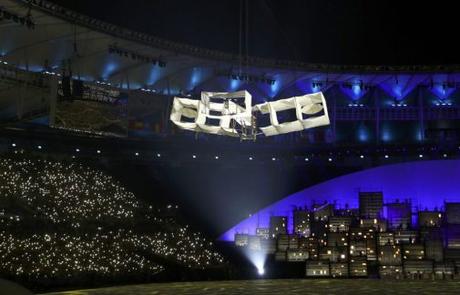
Cue back to the big city — digitally and physically enhanced in the wide-open spaces of Maracanã Stadium. Floating through the airspace, the harmonious sounds of a piano accompanied the voice of Daniel Canneti Jobim, composer Tom Jobim’s grandson, who took center stage. Dressed in a white wide-brimmed hat, he sang and played grandpa’s singular sensational tune, “The Girl from Ipanema,” with lyrics by poet Vinicius de Moraes.
Gliding down the digital runway, and strutting her stuff as only a super-model of her caliber could, stood Gisele Bündchen — a sixth-generation German descendant — in a stunning silver-lamé gown. Tom Jobim’s image was projected thirty-or-more-feet onto the side of a makeshift apartment complex, as the assemblage sang along with the composer’s grandson. Gisele, all smiles, captivated the crowd as she took her sweet time crossing the open field. “When she walks, she’s like a samba / That swings so cool and sways so gentle that / When she passes, each one she passes goes ‘Ah’!”

Switching over to the pop arena, the succeeding segment emphasized the evolution in tastes and musical development with the rise of hip-hop, baile funk, axé, forró, frevo, etc. Popular culture took precedent, with the wailing voices of slum residents. Elza Soares, one of the last surviving grandes dames of variety and theater, sang a brief snippet of Vinicius and Baden Powell’s “Canto de Osanha.”
Along with capoeira, the heavy sound of a cuica pervaded, and Zeca Pagodinho with rapper Marcelo D2, delivering Zeca’s patented ode to better living, the song “Deixa a vida me levar” (“Let life take me along”). The clash of Brazilian musical styles, represented by rap and pop (and contemporary artists Karol Conká and twelve-year-old MC Sofia), continued to duke it out in a syncopated slugfest.
Next up, actress and singer Regina Casé interrupted the proceedings to state her case that we need to “bring people together and celebrate their differences. Here is to diversity.” Joined by the forever youthful Jorge Ben Jor (“Mas, Que Nada”), both artists sang one his signature hits, “País Tropical.” This brought out the warring factions of different colors, strokes, and folks into one patchwork design, as at the beginning of the ceremony. With fireworks exploding and lights blazing, the theme struck up a new: “Looking for similarities, celebrating differences.” That’s something we, here, in the United States have been striving to come to terms with for, oh, two hundred and fifty years, or more.
Pause for Reflection: A Reading from “Nausea and the Flower”
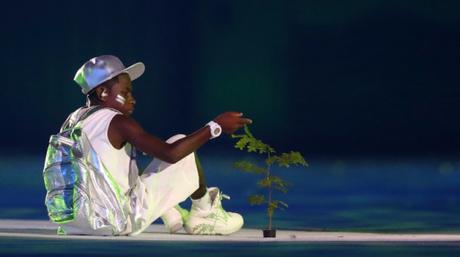
The concluding portions of the ceremony explored the alarming rise in CO2 emissions on the planet, the dangers of unchecked global warming, of climate change, the melting of the polar icecaps, and the rising sea levels, all of them “challenges to the coastline cities.”
A lone boy in shorts and sneakers, with a backpack and form-fitting cap, discovers a single green object growing in the street. It’s a plant. Thus begins a recitation of the final portion of the poem, “A Flor e a Náusea” (“Nausea and the Flower”), by mineiro author and modernist poet Carlos Drummond de Andrade. It would be spoken by two of the world’s greatest actresses, Fernanda Montenegro (in the original Portuguese) and Dame Judi Dench (in English translation). The accompanying music score by Antonio Pinto and Jaques Morelenbaum was taken from the multi-award-winning film Central do Brasil (Central Station):
Uma flor nasceu na rua!
A flower has sprouted in the street!
Passem de longe, bondes, ônibus, rio de aço do tráfego.
Buses, streetcars, steel stream of traffic, steer clear.
Uma flor ainda desbotada
ilude a polícia, rompe o asfalto.
A flower, still pale,
Has fooled the police, it’s breaking through the asphalt.
Façam completo silêncio, paralisem os negócios,
garanto que uma flor nasceu.
Sua cor não se percebe.
Suas pétalas não se abrem.
Seu nome não está nos livros.
É feia. Mas é realmente uma flor.
Let’s have complete silence, hold all business,
I swear that a flower has been born.
Its color is uncertain.
It’s not showing its petals.
Its name isn’t in the books.
It’s ugly. But it really is a flower.
Sento-me no chão da capital do país às cinco horas da tarde
e lentamente passo a mão nessa forma insegura.
I sit down on the ground of the nation’s capital at five in the afternoon
And fondle with my fingers this precarious form.
É feia.
It’s ugly.
Mas é uma flor.
But it’s a flower.
Furou o asfalto,
It broke through the asphalt,
o tédio,
Tedium,
o nojo
Disgust and hate.
e o ódio.
The boy takes the plant and places it gently into a waiting receptacle. Rising from the ground, he holds the object aloft, and silently walks off the stage. Time for the parade of athletes.
(End of Part Three)
To be continued…..
Copyright © 2018 by Josmar F. Lopes
Advertisements &b; &b;
